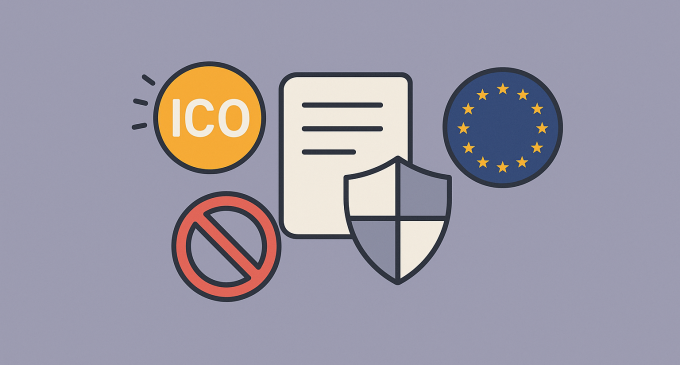
Introduction
The world of cryptocurrency continues to evolve at breakneck speed and one of the areas constantly under scrutiny is Initial Coin Offerings ICOs. Once seen as the Wild West of fundraising in the blockchain space ICOs have become a focus point for regulators aiming to protect investors while nurturing innovation. As of July 2025 European regulatory authorities have introduced a fresh wave of guidance and warnings related to ICO compliance marking a turning point in how digital token projects will be launched and managed across the EU.
The updated guidelines have been issued by a coalition of European financial regulatory bodies functioning similarly to the Securities and Exchange Commission SEC in the United States. Their goal is clear to bring clarity consistency and investor confidence to the ICO market without choking its potential. For many project founders investors and crypto exchanges this new regulatory framework marks a fundamental shift that will have ripple effects far beyond the borders of Europe.
A New Era Of ICO Compliance In The European Union
As of July 1 2025 the European Blockchain Supervisory Authority EBSA working in tandem with the European Securities Market Authority ESMA released new compliance recommendations for projects intending to conduct ICOs within the EU. This guidance was long expected following months of stakeholder consultations and rising concerns over fraud mismanagement and investor exploitation in the digital asset sector.
The July guidance focuses on several key areas including investor protection disclosure requirements token classification AML and KYC mandates and new approval mechanisms for presales and public offerings. The move signals an aggressive pivot away from the lax ICO environment of the past decade toward a regulated regime that echoes traditional capital markets.
Why Was The Guidance Introduced Now?
This new guidance comes in response to a series of high-profile ICO scams and failed token launches that have plagued the European crypto ecosystem over the past 12 months. According to an internal ESMA risk report over 62 percent of ICOs launched in the EU in 2024 failed to deliver either their promised roadmap or token utility leaving investors with significant losses.
Additionally recent economic instability and crypto market volatility have prompted regulatory agencies to step in. With digital assets now being integrated into mainstream financial portfolios across the EU from retail to institutional investors the need for protective structures around ICOs became urgent.
The July 2025 document is seen as a way to strike a balance encouraging blockchain innovation while ensuring projects cannot exploit regulatory gaps.
Core Elements Of The July 2025 ICO Guidelines
The newly released EU guidelines encompass a comprehensive framework that touches every stage of the ICO lifecycle. These are not binding laws yet but serve as strong recommendations with enforcement actions to follow by Q4 2025.
Token Categorization and Legal Definitions
One of the key features of the document is a reclassification of digital tokens. Projects must now identify whether their token falls under security utility or hybrid classifications. Tokens that qualify as securities must register under applicable national and EU-wide capital market rules. Failure to classify appropriately could result in a public warning delisting or project suspension.
This measure aims to reduce the number of projects that misrepresent utility tokens as nonfinancial assets while raising capital in a manner consistent with securities offerings.
Mandatory Whitepaper Disclosures
ICOs will now be required to publish whitepapers adhering to a standardized disclosure format. These documents must detail tokenomics fundraising targets, team qualifications, use of funds technical architecture and risk assessments. Regulators stress that vague or promotional documents will no longer be tolerated. Projects that fail to meet these minimum standards will not be allowed to proceed with their public offering.
Investor Protection and Risk Transparency
Investor safety is at the heart of the new EU policy. New rules mandate that all ICOs implement built-in mechanisms to safeguard investor funds. These include milestone-based disbursements, escrow accounts and regular reporting. Investors must also be warned of all associated risks in clear nontechnical language.
These features are designed to reduce the number of rug pulls exit scams and token failures.
Anti-Money Laundering and Know Your Customer
AML and KYC protocols are now nonnegotiable. ICO projects must implement identity verification for all contributors with data retention procedures that align with the EU GDPR. Anonymous or pseudonymous fundraising models are being phased out. Any ICO found to be accepting funds without adequate AML KYC compliance faces immediate legal scrutiny and asset seizure under EU anti-fraud statutes.
How The Guidance Impacts Crypto Startups And Developers?
While the EU’s new approach has drawn praise from investor advocates it has created fresh challenges for blockchain startups especially smaller teams with limited legal and compliance resources. The burden of legal reviews audits and documentation could slow down many innovative projects or discourage founders from launching within the EU altogether.
To mitigate this the EBSA announced the formation of a regulatory sandbox for blockchain startups. This sandbox will allow new projects to test token sale models within a controlled environment before going fully public. The sandbox model has been used successfully in fintech regulation and may prove vital to preserving innovation in the crypto space.
In addition technical incubators across Germany the Netherlands and France are now working with legal advisory firms to help startups adjust to the new standards. These partnerships are expected to ease the transition and encourage more responsible token development.
Reactions From The Crypto Community And Industry Stakeholders
The July 2025 guidance has stirred up mixed reactions from the broader crypto community. Investor groups have applauded the initiative saying that it will weed out bad actors and restore confidence in the ICO model. Some have even called for a global equivalent of these guidelines to address cross-border ICO fraud.
On the other hand founders exchanges and developers have voiced concern over the increased costs and delays associated with the new framework. In particular concerns have been raised over:
- Ambiguities in token classification.
- Differences in national implementation.
- The absence of fast-track options for low-risk projects.
Many European exchanges including Bitstamp and Kraken EU have responded by creating compliance task forces to help onboard new projects that meet the standard. Several DeFi platforms are also looking to rework their token issuance models to stay aligned with the coming enforcement phase.
Implications For Investors And Market Sentiment
For investors these changes signal a maturing market where due diligence becomes a shared responsibility between regulator and participant. Although the new rules may slow the volume of ICOs in the short term many experts predict that the quality of projects will increase. Reduced fraud risk more transparency and better token design may attract a new wave of traditional investors.
Already data from CoinMarketCap shows that ICO volume in the EU dropped by 15 percent in June 2025 ahead of the guideline release but average project funding rose by nearly 28 percent reflecting a shift toward higher-value launches.
Crypto investment firms such as Blockchain Capital Europe and 21Shares have issued new advisories encouraging clients to seek ICOs that explicitly follow EBSA and ESMA recommendations.
A Glimpse Into The Future Of Global ICO Regulation
The European ICO framework released in July 2025 may serve as a template for other jurisdictions. In fact regulatory bodies in Japan Australia and Singapore are already in discussions with EU authorities about harmonizing international standards. The goal is to create a transparent compliant and border-aware ICO ecosystem that allows for healthy innovation without exposing investors to unnecessary risks.
In the US similar discussions are underway between SEC and industry leaders to build a bridge between utility token models and securities compliance. As these frameworks evolve globally ICOs may finally shed their reputation as risky investments and become trusted instruments of blockchain capital formation.
Conclusion
The introduction of new ICO guidance in July 2025 marks a watershed moment for the European crypto space. As digital finance matures and merges with traditional regulatory structures the Initial Coin Offering model must evolve to meet new expectations around transparency accountability and investor protection.
While challenges remain particularly for small projects and experimental tokens this shift toward structured governance could provide a solid foundation for a more resilient and respected blockchain ecosystem.
For now project founders must adapt quickly, investors must be more selective and regulators must ensure the guidance is enforced fairly and consistently. If these pieces fall into place the ICO could transform from a controversial funding tool into a robust mechanism for responsible crypto innovation across the EU and beyond.







There are no comments at the moment, do you want to add one?
Write a comment